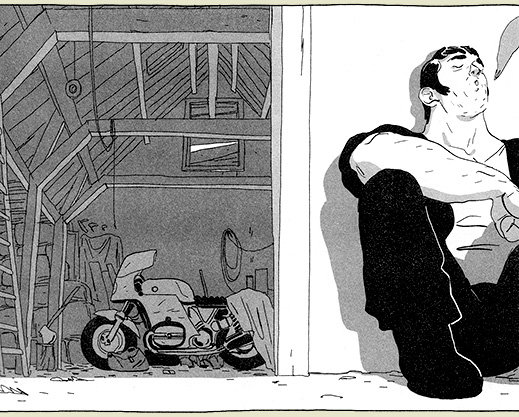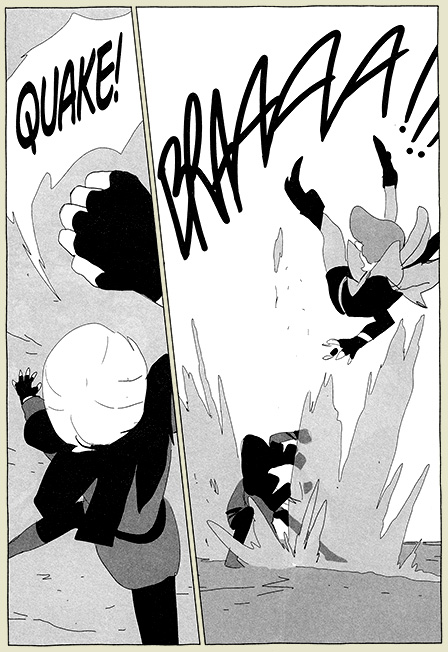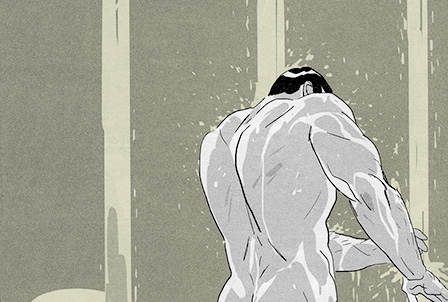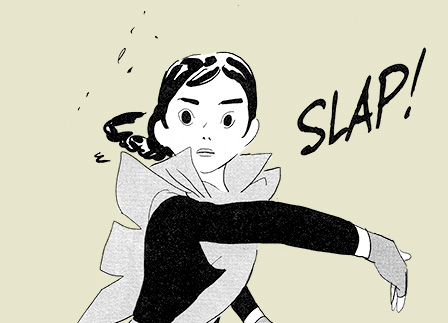Last Man: Vol 2 (The Royal Cup)
Created by: Balak, MichaýI Sanlaville, and Bastien Vivès
Published by: PUBLISHER
ISBN: 1626720479 Amazon
Pages: 208



There are a lot of things I love about manga, but one of the best things about a lot of manga is the absence of a status quo.
A little over twelve years ago, I began a love affair with manga. That's as broad and general as saying that a little over thirty years ago, I began a love affair with women. It's just general and non-committal enough to be nearly entirely meaningless. Really, it probably began the moment I picked up my first issue of Power Pack as a fourth-grader and realized that comics stories could present evolving storylines. Maybe it began earlier, when I read The Chronicles of Narnia as a second-grader and realized that stories could be long, could skip around chronologically, and didn't even have to follow a single character throughout. Maybe my love affair with manga began the moment I first tied a string of letters together to form a word—just like my love affair with women began that moment in kindergarten when I saw one of the second grade girls in a choir performance and her hair was just, just perfect and my heart caught. Neither were what they would be: the girl was not a woman and the word was not manga. But the seeds were there. The origin has a story.

I began a broaching familiarity with manga early on. I read Area 88 occasionally in the early early '90s. I read Akira as Marvel released them across the late '80s and early '90s. I picked up a handful of Robotech comics, which I now realize probably don't actually count at all. But it wasn't until the early-to-mid 2000s that I began actively purchasing manga along with all my other comics and graphic novels. My tastes had yet to refine11In ten years I'm sure to read this and scoff at the idea that I would consider my tastes to have refined by age 40., and I was simply picking up series just to, you know, just to see.
Love Hina. Naruto. Death Note. Plenty of single volumes from those piles of abortive manga detritus that Tokyo Pop was shooting out like a t-shirt cannon with unlimited ammunition. (Gothic Sports!)
Among all the things I love most about manga22Now may be as grand as any place to remark that I don't typically refer to manga as manga. I just call them comics. I don't typically say graphic novels either. I don't find the differentiation usually very helpful. I will, however, occasionally condescend simply because others will find the shorthand useful. While I don't want to underscore in any sense that Japanese comics are fundamentally different from American, Canadian, Hungarian, Korean, or French comics, there is some small social sense in which "our" perception of Japanese comics differs. So to that end, I'll begrudgingly speak of manga.
Otherwise, it's merely a marketing category and I don't actually think those do anybody any good. is that these books often allow for (and sometimes actively pursue) deeply evolving story worlds. Status quo may be decimated at any time.

Marvel and DC superhero books don't actually feature Character in any honest sense of the term. Instead, they feature storytelling engines. Or maybe better, storytelling prompts. A reader of Spider-Man in 1970 can more or less jump into Spider-Man in 2010 and pretty much know exactly what's going on. Only the trivialities (like who is punching Spider-Man now) have changed. Same with Superman, Batman, Captain America. (Maybe not the X-Men? But then again...) Now take something like 20th Century Boys. If you read through volume 4 and then skipped to volume 8, you would both have no idea what was going on and have no way of figuring it out. The world shifted. Same with Akira. Otomo reinvents his entire storyline at least four times throughout the book. Chapter 6 looks entirely different from chapter 14 which looks entirely different from chapter 19. It's exciting, and the books often aren't afraid to change everything along the path to their finale.
While Spider-Man is merely a series of tacitly connected short stories set in the same world and using the same set of characters33It often feels like these stories are the product of a creative writing prompt that generates a pile of stories and then those stories are just published one after another. Then the writers in the study group get another writing prompt that is almost identical to the first and are asked to do that same thing again. It occasionally generates some good stories, but there's not really any reason to keep following the series. You can really just wait until you hear about a particularly good story or anthology and pick up that one., you can sink your teeth into the stories featured in many of these manga. And if you're going to read them, you've got to keep up. Biomega and Knights of Sidonia writhe and shift and go all over the place. Same with Monster and 20th Century Boys. And Negima and Children of the Sea and Flowers of Evil and even Death Note.
Which brings us to Balak, Sanlaville, and Vivès' Last Man series.

With volume 1, Last Man revealed itself to be a superbly designed and deftly paced Fight comic, betraying a certain connection to one of the modes by which shounen manga likes to assert itself. In a way, that first volume felt like it could be a wonderful extrapolation of Negima's Mahora Martial Arts Tournament. It was beautifully scripted and fluidly rendered. Still, not being a particular fan of fight comics, I wondered how the creators could develop the story of a tournament over a full twelve volumes (the length of the series). Volume 2 answers that in the best way, following in one of my favourite manga traditions by decimating what I had imagined was status quo. By the end of the volume, we realize that the last two volumes are mere prologue for what should prove to be a much larger, more satisfying story. And I am blisteringly excited to watch it unfold.
Given the opportunity to ask a few questions of the creators,44These questions are the result of my participation in the Last Man blog tour (even though Good Ok Bad isn't a blog). Here is the schedule for interviews:
Good OK Bad, 6/15
Supernatural Snark, 6/16
The Book Wars, 6/17
Alice Marvels, 6/18
Comics & Cola, 6/19
Fleen, 6/22
Graphic Policy, 6/23
The Book Rat, 6/24
Graphic Novel Resources, 6/25
Women Write About Comics, 6/26 I broach the question of manga:

Question: I've read in other interviews that the storytelling for Last Man is at least somewhat influenced by manga. What aspects of manga in particular are you drawn to and which have you woven into Last Man? (Will we see a manga-style time-skip!)

With volume 1 of the series, we note a heavy emphasis on Hope as a thematic direction. By volume 2 we're seeing the fruit of that and then an evolving exploration of Loyalty. Aldana has at least a temporary loyalty to his young partner Adrian and an abiding loyalty to his own sex drive. Elorna's ties to Gregorio are tested. The queen gives up rooting for the Hometeam to cheer for the Visitors. A pair of lovers are one of the combat teams and have their dedication to each other measured. Marianne has her own interests that bind her to certain paths of action. And Adrian is, of course, guileless and forthright in his passions. These loyalties propel the action in volume 2 and will hold consequences for the remainder of the series.
One of the things I hoped to convey in my review of the first volume but pretty much entirely didn't touch on at all is just how entirely exciting this book is. There is so much going on. One page leads into the next with so much pregnant purpose that it virtually becomes a magnificent feat to put the book down before arriving at its final page. When I finished volume 1, I thought Wow, omigosh. I cannot wait to read volume 2. At the end of volume 2, I thought Wow, omigosh. I cannot wait to read volume 3. And it's not just because these end on cliffhangers. Because they don't. Not really. It's just that you don't want the story to end. You want to devour it all. You want to inhabit their world and see how everything shakes out. Is Adrian going to have to fight Elorna? Will Aldana punch out a woman? What if Adrian has to fight the likes of Cristo Canyon? Will the honey badger have a speaking role? Why is Adrian's mom on a motorcycle on the cover to volume 3??

Obviously, there may be some readers who won't be excited by the book. Hypothetically they must exist. Even if only in our imaginations. But in the small segment of my friends to whom I've leant the book, nobody does not devour it. My wife, who is even less invested in fight comics than me, loves it. My co-worker, who probably has an unhealthy interest in comics featuring terrible fights (he adores Jojo's Bizarre Adventure and pushes it on me regularly), loves it. I love it. You probably will as well. Last Man is the ongoing series that most excites me at the moment.

Question: Do you see Last Man as wholly an adventure? Or as an exploration of ideas in addition to being a kick-ass compulsively readable adventure? Or something else?

Even a cursory read offers ample evidence that Last Man would have actually made a hot hentei comic had the creators wished to move in that direction. Vivès and Sanlaville draw ridiculously good-looking people who exhibit a sensuous kind of physicality. For all its PG-rated coyness,55Or maybe PG-13, I guess? Last Man is a pretty sexy book. Aldana is all muscles and masculinity and has a bathing scene that pretty obviously smokes. I don't know whether it's intended to appeal to the female gaze or the gay male gaze (though the two seem to increasingly blend and blur), but I doubt there are many from either side of the coin who will be sad.

All that aside though, I'm glad they decided against making a porn comic because then I wouldn't be talking about the book here. And this is such a lovely, exciting book that I need to talk about it. The artists portray so much elegance of motion that even heavy, stomping, oxen men move with a kind of liquid energy. Certainly more like a crashing wave than something more gentle, but still. More lithe figures like Adrian exhibit the same sense of weightlessness as the dancers in Vivès earlier work, Polina. The backgrounds, too, are skillfully devised with all manner of unexpected detail. A dragon here, a crowd reaction there. Altogether lovely.

Question: Last Man seems a seamless effort of a single artist, but to know all three of you worked together in some sense blows my mind. How similar are your art styles naturally? Have you had to abandon common traits of your art to achieve such a unified aesthetic?

And without segue...

Question: From what I've read, the story of Last Man is is going to play out across twelve comics volumes, a videogame, and an animated film. How necessary will these non-comics additions be to enjoying the story and do you believe we will have them available in the US?

One of the things I loved about Negima was the unveiling of a large and full cast of characters. That book had plenty of volumes to move about and explore the numerous personalities that comprise the core of its narrative thrust. By the time of the Mahora Martial Arts Tournament (a big magical combat tourney occurring about 1/3 through the series), we've had ten volumes by which to grow attached to all the competitors—essential for creating reader interest in the battles.

Balak, Sanlaville, and Vivès accomplish this in a volume or two. Readers are easily invested in Adrian's and Aldana's stories—and in Elorna's as well. We know enough about Gregorio to know exactly how we want to see his fights end. Alyssa's fight is a surprise and plays well off a moment from volume 1. And of course there's the mystery behind the champions, Cudna and Cristo Canyon. All of this works so flawlessly because these are characters we know; we've been insinuated into intimate moments of their lives and persons through subtle expressions and body language. It's all so very well done.

Question: Do you have a favourite character from the series or one who particularly resonates with you? Is it a character we've seen or one to be revealed after volume 2? (Elorna is a favourite of mine so far and I hope we'll see more from her somehow.)

Mic's favorite character is Cristo Canyon, because he looks very calm and yet he's very powerful. He’s a very complex and important character too. Bastien's favorite is definitely Adrian Velba. The mother/son relationship means a lot to him. And Balak's favorite is Richard Aldana, because he's a "perdant magnifique" (“beautiful loser"), as we say in French.
It's hard for me not to gush over Last Man. For whatever reason, I am tempted to pretend that I'm above passionately boosting for a series. All the same though, I've long argued for the essential subjectivity of the critic's role—and even more than a critic, I count myself an evangelist for good comics. And Last Man is good comics. Actually, it's very good comics. So maybe now I'll have another book to recommend constantly and incessantly and breathlessly forever—right alongside Cross Game, the book I'm currently most known for hyping rabidly.
Good Ok Bad features reviews of comics, graphic novels, manga, et cetera using a rare and auspicious three-star rating system. Point systems are notoriously fiddly, so here it's been pared down to three simple possibilities:
3 Stars = Good
2 Stars = Ok
1 Star = Bad
I am Seth T. Hahne and these are my reviews.
Browse Reviews By
Other Features
- Best Books of the Year:
- Top 50 of 2024
- Top 50 of 2023
- Top 100 of 2020-22
- Top 75 of 2019
- Top 50 of 2018
- Top 75 of 2017
- Top 75 of 2016
- Top 75 of 2015
- Top 75 of 2014
- Top 35 of 2013
- Top 25 of 2012
- Top 10 of 2011
- Popular Sections:
- All-Time Top 500
- All the Boardgames I've Played
- All the Anime Series I've Seen
- All the Animated Films I've Seen
- Top 75 by Female Creators
- Kids Recommendations
- What I Read: A Reading Log
- Other Features:
- Bookclub Study Guides









